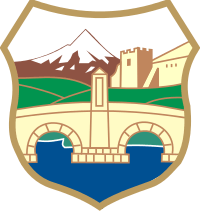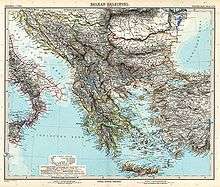Ss. Cyril and Methodius University of Skopje
| Универзитет „Св. Кирил и Методиј“ во Скопје | |
 | |
| Type | Public |
|---|---|
| Established |
19 December 1943 (State Boris III the Unifier University) 24 April 1949 (official) |
| Rector | Prof. Dr. Velimir Stojkoski Vet. M.D. |
Academic staff | 2390 |
| Students | approximately 50,000 |
| Location |
Skopje, Macedonia |
| Campus |
app. 90,000 m² (main campus) |
| Affiliations |
ERA |
| Website | ukim.edu.mk |
The Saints Cyril and Methodius University of Skopje (Macedonian: Универзитет „Св. Кирил и Методиј“ – Скопје) is the largest university in the Republic of Macedonia. It was named after the Byzantine Christian theologians and Christian missionaries Cyril and Methodius, originated from Thessalonica, and considered as the 'apostles of the Slavs', enlighteners who developed the precursors to the Cyrillic script used today in most Slavic languages. More than 50,000 students study at the Skopje University, including some 700 foreign students. Furthermore, the teaching and research staff number 2,390 people; this is further supported by over 300 members in the university's institutions.
The primary language of instruction is Macedonian, but there are a number of courses which are carried out in English, German, French, Italian and minority languages.



Departments and faculties
The university is divided into 23 faculties and 10 research institutes:
Faculties
- Faculty of Philosophy
- Founded in 1946
- 12 undergraduate study programmes
- 17 postgraduate study programmes
- "Blaže Koneski" Faculty of Philology
- Founded in 1946
- 11 undergraduate study programmes
- 13 postgraduate study programmes
- Faculty of Natural Sciences and Mathematics
- Founded in 1946
- 24 undergraduate study programmes
- 31 postgraduate study programmes
- Faculty of Agricultural Sciences and Food
- Founded in 1947
- 10 undergraduate study programmes
- 24 postgraduate study programmes
- Faculty of Forestry
- Founded in 1947
- 4 undergraduate study programmes
- 17 postgraduate study programmes
- Medical Faculty
- Founded in 1947
- 3 undergraduate study programmes
- 24 postgraduate study programmes
- "St. Clement of Ohrid" Faculty of Pedagogy
- Founded in 1947
- 6 undergraduate study programmes
- Faculty of Architecture
- Founded in 1949
- 1 undergraduate study programme
- 4 postgraduate study programmes
- Faculty of Civil Engineering
- Founded in 1949
- 5 undergraduate study programmes
- 4 postgraduate study programmes
- Faculty of Economics
- Founded in 1950
- 7 undergraduate study programmes
- 10 postgraduate study programmes
- "Iustinianus Primus" Faculty of Law
- Founded in 1951
- 3 undergraduate study programmes
- 6 postgraduate study programmes
- Faculty of Mechanical Engineering
- Founded in 1959
- 9 undergraduate study programmes
- 6 postgraduate study programmes
- Faculty of Electrical Engineering and Information Technology
- Founded in 1959
- 8 undergraduate study programmes
- 9 postgraduate study programmes
- Faculty of Technology and Metallurgy
- Founded in 1959
- 9 undergraduate study programmes
- 16 postgraduate study programmes
- Faculty of Stomatology
- Founded in 1959
- 3 undergraduate study programmes
- 7 postgraduate study programmes
- Faculty of Music
- Founded in 1966
- 27 undergraduate study programmes
- 36 postgraduate study programmes
- Faculty of Dramatic Arts
- Founded in 1969
- 7 undergraduate study programmes
- 13 postgraduate study programmes
- Faculty of Physical Education
- Founded in 1977
- 2 undergraduate study programmes
- 2 postgraduate study programmes
- Faculty of Pharmacy
- Founded in 1977
- 2 undergraduate study programme
- 9 postgraduate study programmes
- Faculty of Fine Arts
- Founded in 1980
- 4 undergraduate study programmes
- 3 postgraduate study programmes
- Faculty of Veterinary Medicine
- Founded in 1991
- 1 undergraduate study programme
- 5 postgraduate study programmes
- Faculty of Design and Technologies of Furniture and Interior
- Founded in 2010
- 2 undergraduate study programmes
- 8 postgraduate study programmes
- Faculty of Computer Science and Computer Engineering
- Founded in 2010 by uniting of institutes (institutes founded 1982)
- 8 undergraduate study programmes
- 16 postgraduate study programmes
Research Institutes
- Institute of Agriculture
- Founded in 1923
- Institute of National History
- Founded in 1948
- "Marko Cepenkov" Institute of Folklore
- Founded in 1950
- Institute of Cattle Breeding
- Founded in 1952
- Institute of Economics
- Founded in 1952
- "Krste Misirkov Institute of the Macedonian Language"
- Founded in 1953
- Institute of Sociological, Political, and Juridical Research
- Founded in 1965
- Institute of Earthquake and Seismology Engineering
- Founded in 1965
- "St. Clement of Ohrid" Faculty of Theology
- Founded in 1977
- Institute of Macedonian Literature
- Founded in 1998
History

During the Bulgarian occupation of Vardar Banovina (1941-1944) the new authorities established in 1943, in Skopje, Macedonia's first institute of higher education - the Tsar Boris III University.[1] Due to the withdrawal of the Bulgarian administration in the Autumn of 1944, the University stopped its educational activity. However, after the establishment of the Socialist Republic of Macedonia, on the third session of the Presidium of the Antifascist Council of the National Liberation of Macedonia, held in April 1945, one of the items on the agenda was the question of opening a Macedonian university to replace the Bulgarian one.[2] At the end of 1946, the concept of a university began to be realized and the official opening ceremony for the Faculty of Philosophy, the cornerstone of the University of Skopje, took place on 29 November of that year. This marked the beginning of a Macedonian state university. The first faculty consisted of the Department of History and Philology and the Department of Mathematics and Natural Science, while the Medical Faculty and the Faculty of Agriculture and Forestry were added in 1947. Fifty-eight students enrolled during the first academic year of 1946–1947; in the next year this number grew to 907. The development of higher education in Macedonia was characterized by rapid growth, and several other faculties were added in the following years. Parallel to the education activities in the existing faculties, scholarly research was undertaken with the development of independent institutes of research. Thus, the Institute of National History was founded in 1948, followed by Institute of Folklore in 1949, and the Institute of Economics in 1952. Today, there are 10 research institutes affiliated with the University of Skopje.
After the great 1963 Skopje earthquake, which destroyed most of the city of Skopje, the university was leveled and some of the most modern laboratories in Yugoslavia were destroyed. By this time the University of Skopje was the third largest in Yugoslavia. It was quickly rebuilt on the premises of a much larger and modern urban campus. At the request of Yugoslav authorities, scientists from UNESCO's Department of Natural Sciences were sent to meet with the university's scientists to develop plans for the rehabilitation of the university's science laboratories. As a result, a large donation of equipment for science teaching and research was gathered from around the world through UNESCO's international programme of aid to Skopje.
At present, the University of Skopje is carried out in the spirit of the 1991 Constitution of the Republic of Macedonia, which incorporated the social, economic and political changes that had taken place after Macedonia proclaimed its independence from the Former Yugoslav Federate State. On 3 August 2000 the Parliament of the Republic of Macedonia brought the new Law on Higher Education which adopted the overall European standards of higher education. The management organs of the university are the University Senate, consisting of two staff members from each faculty and scientific research institutes, five appointed members by the government of the Republic of Macedonia and five students delegated from the Student Organization; the University Board, consisting of the rector, the vice-rectors, the secretary general, the deans of the faculties, the directors of the scientific-research institutes and one student representative; and the rector. The university represents a functional community of 25 faculties and 10 research institutes.
Mission
The Ss. Cyril and Methodius University’s mission is to be an:
- autonomous, scientific and higher educational university that provides teaching, scholar and applicative activities in technical, natural sciences and mathematics, bio-technical, artistic, medical and social sciences;
- university devoted to the cherishing as well as the international affirmation of the traditional features and values of the Macedonian people such as: the Macedonian language, the history, the literature and culture of the Macedonian people and also the cultural values of the ethnic communities in the Republic of Macedonia;
- university open for all students on the basis of equality and their results regardless of their ideological, political, cultural and social background;
- university that concords its academic offer to the needs of its social surrounding and has a continuously dynamic relationship with it;
- university that creates stimulative surrounding for its employees providing them a progress of their abilities in order to accomplish its mission;
- university that develops long-life and continuous education;
- university determined to achieve the European norms and standards in all spheres of its activities.
Alumni
- Džordže Arsov – Mayor of Kisela Voda
- Dimitar Bogov – Governor of National Bank of the Republic of Macedonia
- Ljube Boškoski – Former Minister of Internal Affairs of Macedonia
- Vlado Bučkovski – Former Prime Minister of Macedonia
- Branko Crvenkovski – 3rd President of Macedonia
- Živko Čingo – Writer
- Georgi Efremov – Macedonian Academician and scientist at Macedonian Academy of Sciences and Arts in the field of Genetic Engineering and Biotechnology
- Fatmir Besimi – Minister of Economy
- Nikola Dimitrov – Former Deputy Minister of Foreign Affairs and Macedonian Ambassador to the United States
- Igor Durlovski – Opera singer
- Lazar Elenovski – Former Minister of Defense
- Taki Fiti – Former Minister of Finance
- Ljubomir Frčkoski – Author of the Constitution of Macedonia
- Ljubčo Georgievski – Former Prime Minister of Macedonia
- Maja Hill - Artist. Formerly Maja Dzartovska
- Gjorge Ivanov – President of Republic of Macedonia and Supreme Commander-in-Chief of Macedonian Army
- Zoran Jolevski – Macedonian Ambassador to the United States and Negotiator for the Macedonia naming dispute
- Sasho Kalajdzievski – Professor of Mathematics, University of Manitoba in Canada
- Sashko Kedev – Former Presidential Candidate
- Gabriela Konevska-Trajkovska – Deputy Prime Minister in charge of European Integration
- Trifun Kostovski – Businessman and Former Mayor of Skopje
- Jagnula Kunovska – Member of Parliament
- Sehadete Mekuli – gynecologist
- Antonio Milošoski – Minister of Foreign Affairs
- Judge Branko Naumoski – Chief Justice of the Constitutional Court of the Republic of Macedonia
- Tito Petkovski – Member of Parliament
- Filip Petrovski – Former Member of Parliament and Director of the City Library
- Luan Starova – writer and scholar
- Zoran Stavrevski – Deputy Prime Minister and Minister of Finances of Macedonia
- General Miroslav Stojanovski – Chief of General Staff of Republic of Macedonia
- Sir Boris Trajkovski – 2nd President of Macedonia
- Vasil Tupurkovski – Macedonian Politician
See also
- Balkan Universities Network
- List of colleges and universities
- Macedonian Journal of Medical Sciences
- Skopje
References
- ↑ A Concise History of Bulgaria, R. J. Crampton, Cambridge University Press, 2005, ISBN 0521616379, р. 168.
- ↑ Historical Dictionary of the Republic of Macedonia, Dimitar Bechev, Scarecrow Press, 2009, ISBN 0810855658, Introduction, p. XIV.
External links
- Ss. Cyril and Methodius University of Skopje Website (English)
- Departments:
- Medical sciences: Medicine, Dentistry, Pharmacy, Physical Education
- Technical sciences: Natural Sciences and Mathematics, Architecture, Civil Engineering, Mechanical Engineering, Faculty of Electrical Engineering and Information technology, Technology and Metallurgy
- Social sciences: Philosophy, Philology "Blaze Koneski", Economics, Law "Iustinianus Primus", Pedagogy "St. Clement of Ohrid"
- Biotechnical sciences: Agricultural Sciences and Food, Forestry, Veterinary Medicine
- Arts: Music, Dramatic Arts, Fine Arts
Coordinates: 42°0′1.27″N 21°26′36.17″E / 42.0003528°N 21.4433806°E

